Popcorn in Cuzco

You know it is magic. In this day of science we take so many things for given and this is really ordinary, something we have seen all our lives. But, you have to admit it is magic when a little grain of corn bursts open into a white soft flower, magnitudes its size. So much lies hidden in that little explosion that has even claimed Cuzco, as we shall see.
Segue to the early days, the days before pottery. At this time, some 6,700 years ago, people on the Peruvian coast were raising corn having somehow brought it from Mexico where it was domesticated a couple of thousand years earlier. Archeologists, such as Tom Dillehay (who singlehandedly has been pushing back the dates of the first settlement of the new world and breaking conventional wisdom) found evidence of corn production and use, including popcorn, much earlier than they had anticipated at the important coastal and pre-Inca site of Huaca Prieta.
Furthermore, they found varieties like the major three still found and used in Peru. But, unlike those, the history of popcorn bursting onto Peru’s streets is a much more recent one. It is not one of continuity with an ancient past.
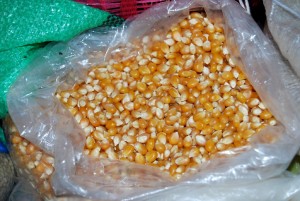
Instead its a story that begins in North America where popcorn had its own indigenous history and was one of the first snack foods, the other being peanuts. Prior to the growth of cities and industrialization in the early twentieth century there were no snack foods sold on city streets, according to Andrew Smith in his book Popped Culture. While he is probably right about changes that led to today’s industrial snack foods, I am a bit skeptical there were no snacks.
Nevertheless, Smith makes a good point about the importance of snacks to workers and others in the new city life. The magic of popcorn held sway both for producers and for consumers because it was simple and relatively clean. It did not have the peanut shell that had to be opened before the roasted peanuts could be found and then discarded, making a mess. By World War II popcorn became so popular as a snack that it was increasingly produced industrially–as poppers and condiments were made into a whole package. In addition the corn was raised often far away. Argentina, in South America was a major grower of popping corn.

While in much of the rest of the world American soldiers played a big role in the spread of popcorn as snack, we do not know that for Peru and other areas of South America. The American ex-pat population involved in commercial and economic development as well as American cultural affairs may well have played a role.
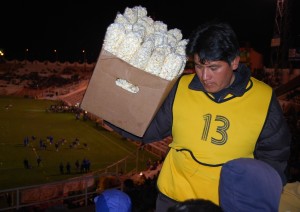
But the spread of Hollywood movies undoubtedly did play a part, since the magic of the big screen was tied tightly to the profit making magic of concessions. Cuzco does not have a movie theatre presently and has not for some time. But it once had several, during the heyday of Hollywood and theaters.
I do not know if they played a role in the spread of a habit of eating popcorn while watching a movie. But in Cuzco today eating popcorn and movies are tied together tightly. People will make popcorn at home when they pop DVD into their player.
Popcorn also built a connection with schools and children. It is sold at the door of almost every school as an inexpensive but tasty snack for kids to buy during their “recreo,” recreation.
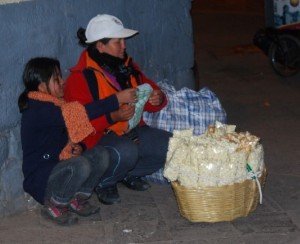
But it is also found for sale on every street corner and in the bus terminals. From five in the afternoon popcorn sellers move into the street to sell to the people ending their work day and moving through the streets, either on their way home or just enjoying a “paseo,” a stroll. Some vendors push mobile poppers with them to their “puesto,” their established place, where they sell both salty and sweet popcorn. Others carry baskets with plastic bags stuffed with recently popped corn.
While the salty form has become the most common, the sweet is very Peruvian and has its audience. While the salty just has salt sprinkled on it after popping, the sweet has sprinkles of colored sugar balls, the same ones added to Cuzco’s Holy Week empanadas to give them color.
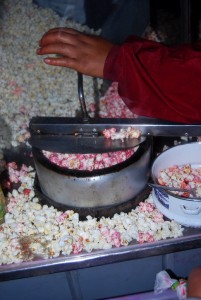
The magic of popcorn has antiquity in Peru but it came this time with the magic of the market and the development of a modern, commercial economy. However in Cuzco it is made and sold by small-scale vendors while in the United States popcorn is dominated by the large commercial producers, making it a capitalist snack par excellence,
Cuzco’s popcorn is grown in the nearby Sacred Valley by family farmers while elsewhere it is grown on huge industrial farms. Many people have left the rural areas but the land has not been consolidated into huge industrial farms.
Although popcorn may have spread with the growth of a mass, commercial culture that turned farmers into an urban working class and that brought foods such as panetones, in Cusco it remains a small scale endeavor. Making and selling popcorn has become one of many ways that working-class people find to make a living through micro enterprises of buying, making, and selling.

The new custom of popcorn may have come from somewhere else, but now it has become thoroughly ingrained in peoples lives where it is a popular snack food for parties, while in the street, or for watching films. It is an inherent part of growing up in the Incan capital.
While other countries have ranges of names for it in Spanish, from palomitas to pororó and pipoca, in Cuzco they have given it the endearing word that is used for other toasted corn, canchitas. It has become part of the city and its traditions and its own sense of magic.
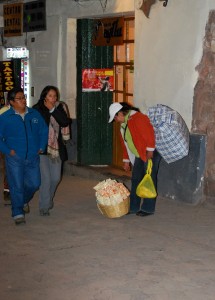





How is cuzco popped in Peru
Hello George,
Regular popcorn, such as in this article, is just made in a heated pan with a little oil. People either make it at home, or if the intend to sell from a cart, they purchase the cart with a burner and a lidded pan in which they can cook the corn till it pops.